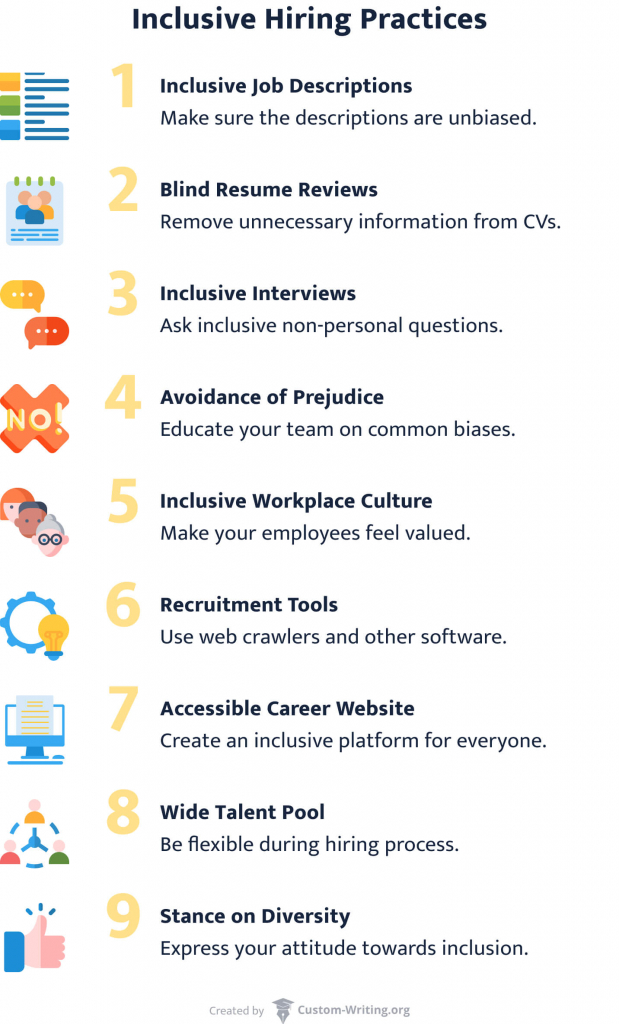In recent years, the importance of providing equal opportunities to people from minority and marginalized groups became especially evident. Prioritizing minority groups contributes to society at large, and what’s more, it also helps to improve companies.
While the advantages of embracing diversity in a workplace are finally being recognized, implementing the right strategies to promote inclusivity remains a challenge for many business leaders.
This article by Custom-Writing.org will:
- explain what inclusive recruitment is about;
- talk about the importance and benefits of inclusive recruitment;
- introduce 9 effective inclusive hiring practices.
👥 What Is Inclusive Recruitment/Hiring?
You’ve probably heard about practices like interviewing and recruiting people of various backgrounds, ages, and races. These practices are part of inclusive hiring—an approach aimed at building a diverse team that is pushed to think outside of their comfort zone and come up with inspiring ideas.
Here are some features of inclusive hiring:
- Acknowledging and embracing diversity
- Ensuring fair hiring practices
- Preventing discrimination
- Using inclusive forms of communication
- Taking into account various opinions
- Having an intersectional approach
Employers sometimes have prejudices and use discriminatory hiring methods that prevent people from getting jobs based on their background, race, or gender. This approach makes it difficult for companies to achieve a diverse workforce.
Many businesses highly prioritize inclusiveness. In order to ensure diverse recruiting practices and avoid discrimination, they’ve created special diversity and inclusion jobs. People who work there strive to cultivate a workplace where all staff feel appreciated and have equal chances to advance.
Workplace Inclusivity Infographic
Diversity and inclusion help create a welcoming atmosphere for every employee. But that’s not their only benefit. They also provide firms with unique advantages. Want to know more? Look through this infographic:

Diversity and Inclusion in Workplace
Conversations about recruiting often include terms like “diversity” and “inclusion.” To recognize what it means to have an inclusive workplace, we first need to figure out the meaning of the word “diversity.”
Here’s how to define it:
Diversity is a range of differences among people in any group, including personality, thinking abilities, age, and ethnicity. A diverse workplace comprises people from an array of backgrounds, with varying experiences, ages, and races.
Inclusion and diversity go hand in hand during the recruiting process. The difference is that while diversity is a set of characteristics, inclusion is the attitude towards these characteristics.
An inclusive workplace empowers and listens to the voices of all its diverse employees. Inclusion is about understanding and respect. It makes every team member feel accepted and encourages them to be part of the decision-making process.
❓ Why Is It Important?
Having diverse teams is essential in the global world. There are several reasons why inclusivity is a critical component of the workplace. Keep reading to find out more!
Benefits of Inclusive Recruitment
It’s not a secret that today, countless businesses and organizations strive to be more inclusive and diverse. The policy of inclusion has numerous benefits that allow firms to succeed. Let’s discuss some of them:
⭐ Benefit 1: More opportunities to hire brilliant people.
Despite their excellent abilities, talented individuals are often turned down due to their race, gender, or personal characteristics. Reducing prejudice and inequality means a business will have more opportunities to employ talented candidates who add value to the team.
⭐ Benefit 2: Diverse viewpoints and approaches.
A team that is made of people from dissimilar backgrounds will provide a broader range of perspectives. This may help avoid herd mentality and result in more creativity.
⭐ Benefit 3: Innovations.
Companies with more diversity and an open, friendly culture foster creativity and innovation. Workers feel less stress and are more comfortable sharing ideas when the environment is positive. Studies show that companies with above-average diversity are 19% more innovative than those with below-average diversity.
⭐ Benefit 4: Empowerment.
Including people with disabilities or those from less privileged backgrounds encourages them to pursue opportunities and reduces discrimination in society.
⭐ Benefit 5: Promotion of tolerance and acceptance.
Organizations that are diverse and inclusive make their employees feel fulfilled and benefit the public at large by promoting equality. This helps to build a more open-minded society.
⭐ Benefit 6: Better business outcome.
It has been proven that in the US, ethnically diverse companies are 33% more likely to outperform less diverse companies in profitability.
⭐ Benefit 7: Positivity.
Inclusivity and equal opportunities for workers help to spread a positive message and encourage diverse thinking. In turn, this creates an environment in which everyone is valued.
Inclusive Hiring: Reducing Bias
Even though inclusivity has many benefits and various organizations try to foster it, not all employers consider diversity during their interviews and assessments. There are times when employees are met with bias due to their personal characteristics, gender, race, or sexuality. This kind of discrimination negatively influences both the company and society at large. It hampers diversity and leads to bad hiring decisions.
Employers can often be biased unconsciously. These biases usually come from a person’s background.
Here are the most widespread unconscious biases:
- Affinity bias: a tendency to prefer individuals similar to you in race, gender, or age.
- Confirmation bias: an inclination to focus on facts that reinforce your pre-existing views or stereotypes.
- Attribution bias: a tendency to have a different rationale for your own behavior versus others’ actions.
- Conformity bias: a case when a person is affected or pressured by another’s opinion and behavior.
- Gender bias: a tendency to choose one gender over the others.
- Racial bias: favoring one person over the other because of their race.
Although these biases may be unintentional, that doesn’t mean they shouldn’t be addressed. Inclusive hiring strategies can help stop discrimination when employing new people.
👍 9 Proven Inclusive Hiring Practices
Completely avoiding discrimination during the hiring process may seem almost impossible. Indeed, the task is not easy. However, there are some proven and effective strategies that help to prevent bias during interviews and to ensure inclusive recruitment.

1. Write Inclusive Job Descriptions
When it comes to a job description, it’s best to make it as unbiased and inclusive as possible. Using gender-coded words and complicated terminology is counterproductive. Instead, the company should talk about what each worker gains by becoming part of the team. For instance:
- Paternal leave
- Flexible hours
- Remote work
- Sick leave
2. Conduct Blind Resume Reviews
Most organizations are aware of the existence and impact of unconscious bias. To avoid discrimination and make the hiring process more efficient, companies should conduct blind resume reviews. It’s better to remove any information about applicants’ gender, educational institutions, and nationality.
It’s also best if the HR team is diverse and consists of people from different backgrounds. This kind of policy will ensure that every candidate has an equal chance of getting the spot.
3. Use Inclusive Interview Questions
Good interview questions are designed to help find the most suitable candidate for a position. They support inclusivity and allow every potential worker to demonstrate their abilities. It’s best to use gender-neutral questions and ask about personal experience.
Diversity among the interview panels is another important factor that contributes to inclusivity and helps to avoid discrimination.
4. Educate Your Team on Common Biases
Educating employers on common biases is a crucial step in creating a diverse and inclusive work environment. Every member of the recruiting team needs to be aware of their own prejudices and work to overcome them. This will ensure a fair hiring process.
We’ve already talked about the most common hiring biases. Is there a way to combat them? Let’s examine the solutions that can help you avoid common biases:
- Affinity bias. Workers could take note of similarities they share with a candidate. This helps to distinguish between the biases recruiters have and the actual skills or experience of the interviewee that could contribute to the team in the future.
- Confirmation bias. Asking skill-based questions is key. Questions that talk about the candidate’s characteristics and knowledge help each interviewee to stand out.
- Attribution bias. Judging or drawing conclusions too quickly can end up in discrimination. If a candidate is late or nervous, it’s better to ask questions to clarify the situation instead of assuming they have no work ethic.
- Conformity bias. Collecting personal opinions of every recruiter is an excellent way to avoid conformity. Each member of the recruiting team needs to have a chance to express their point of view.
5. Create Inclusive Workplace Culture
Inclusivity in itself is great. However, creating a friendly atmosphere where every employee can flourish is even more critical. It takes time and dedication, but it’s not impossible. To create an inclusive workplace culture, it’s best to:
- Encourage collaboration;
- Take everyone’s opinion into consideration;
- Model inclusive language (for instance, use “spouse” or “partner” instead of “wife” or “husband”);
- Reward and recognize everyone’s performance;
- Make sure that your workplace is accessible.
6. Use Inclusive Recruitment Tools
The job advertisement is something that deserves special attention from every employer. Language plays an important role here. Is it inclusive, or does it imply that you are looking for someone from a particular background?
One way to avoid bias is to use proofing tools (such as Ongig’s Text Analyzer) or web crawler software (such as Entelo.) These programs help identify words or phrases that may subconsciously discourage candidates of certain backgrounds from applying to the job.
7. Make an Accessible Career Website
A career website is an important platform for many workers. For that reason, it’s essential to create and optimize the correct design. Simply sharing stock photos of a “diverse” workforce on the webpage may not be enough. It might be helpful to incorporate more videos with subtitles and closed captions for people with hearing disabilities and to use gender-neutral language to ensure that anyone who visits the platform feels included.
8. Widen the Talent Pool
When an organization is hiring for an open position, it often chooses candidates based on a particular set of qualifications. These guidelines can be helpful, but sticking too strictly to them can do more harm than good. There is a chance to lose someone who fits the position perfectly only because they have less experience or a different degree.
Being flexible is important. For example, a company could consider candidates with less experience or with various levels of degrees. Building a diverse talent pool broadens the company’s perspective. Diverse qualifications add value to the team.
9. Express Your Company’s Stance on Diversity
To attract more people from various backgrounds, a company needs to let potential workers know about its stance on inclusivity and diversity. Working on the company’s image is something that takes time but always pays off. When a company posts a job opening, the advertisement needs to speak for itself. It’s best to use inclusive and neutral language in the vacancy description section and mention the company’s inclusive policy.
Making your stance clear is essential. Companies that talk or post articles about diversity get 25% more responses from women than those companies that rarely speak up on the issue.
To sum up, diversity and inclusion in the workplace are two significant factors that affect both employers and employees. Every employer should consider them and provide every candidate with equal opportunities.
We hope that this article was helpful! Make sure to apply our tips and make your workplace more comfortable for everyone.
🔍 References
- What Does It Really Mean to Be Inclusive in Recruitment?: Page Executive
- How to Show Candidates You’re Committed to Diversity and Inclusion in Hiring: Monster
- The Importance of Inclusive Recruitment: Hireology
- Diverse Hiring: 6 Steps To Hiring More Diverse Candidates: Ideal
- How to Make Inclusivity More than Just an Office Buzzword: Northwestern University
- The Business Case for Inclusive Hiring Practices: HireVue
- 3 Essentials to a More Inclusive Hiring Process: The University of Virginia
- How to Leverage Inclusive Hiring Practices for Your Business: ADP

![Changing Career Paths after Graduation… or Later [Guide + Infographic]](https://custom-writing.org/blog/wp-content/uploads/2021/09/Changing-Career-Paths-after-Graduation-or-Later-284x153.jpg)
![Being a Successful Online Student: 6 Must-Have Skills [Infographic]](https://custom-writing.org/blog/wp-content/uploads/2021/09/Being-a-Successful-Online-Student-284x153.jpg)

![Meeting Deadlines: A Comprehensive Guide [Tips & Infographic]](https://custom-writing.org/blog/wp-content/uploads/2021/07/flat-lay-desk-calendar-clock-284x153.jpg)
![Getting the Most Out of Career Fairs [The Complete Guide]](https://custom-writing.org/blog/wp-content/uploads/2021/07/company-representatives-reading-applicant-resume-hiring-284x153.jpg)





